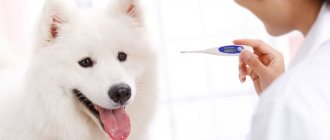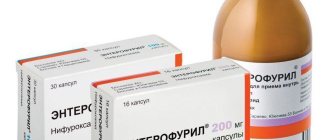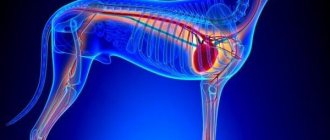There are many possible situations in which your dog may urgently need medication. These include minor scratches or abrasions, minor manifestations of allergies, as well as cases when emergency assistance is necessary.
Photo: Maria Eklind
Any medicine should be used only after consultation and prescriptions from a veterinarian; independent use of drugs is unacceptable. Even experienced dog breeders cannot take into account all the breed characteristics and health status of the animal, know the effect of medications and the possibility of combining them in full.
Therefore, a first aid kit at home is a necessity, but medications should be given to the dog only as prescribed by a doctor.
How to understand at home that a disease is beginning
The first signs of illness in a puppy and an adult dog are:
- increased body temperature;
- diarrhea;
- vomit;
- rapid breathing;
- smooth muscle spasms;
- whining;
- the dog tucks its tail and hides;
- discharge from the ears or nose;
- festering eyes;
- unpleasant odor from the ears or mouth;
- skin rashes or itching.
If one of the listed symptoms is present, do not panic. First, call your breeder or veterinarian. They will be able to help with competent advice.
It is possible that you can handle your dog’s treatment on your own. In any case, you will definitely be able to provide first aid.
Of course, we are not talking about dangerous viral diseases: plague, rabies, enteritis, hepatitis, leptospirosis, which are strictly prohibited from being treated independently.
In addition, do not thoughtlessly use medications from your “human” kit.
Human medications are prescribed to dogs by a veterinarian. Many of the medications we take are deadly to dogs. Example: Children's Nurofen can cause bleeding and kill a pet in a matter of hours.
Start of the trip: preparing your pet
You must wear a collar or harness on your pet and take a leash with you. All animals handle travel differently. Those who are accustomed to transport can easily sit in the car seat or be held in the arms of the owner. And some are very worried and, due to stress, can jump out if a door or window is accidentally opened. This is dangerous, because you can end up under the wheels of oncoming traffic. Therefore, it is better to put such a pet (a cat or a small breed dog) in a carrier for peace of mind.
Often, due to motion sickness on the road, animals experience nausea, vomiting or drooling. If this is typical for your pet, it is better to feed it 4-5 hours before leaving so that most of the food passes from the stomach further through the intestinal tract. And a few hours before the trip he needs to be given one of the following medications:
- Serenia in tablets is sold in veterinary pharmacies. It must be given according to instructions. If you bought the drug in injection form, then the recommended dose is 0.1 ml/kg subcutaneously, at the withers.
After the injection (injection), the injection site should be massaged. The injection technique is described on our website in the “Knowledge Base” section.
- Espumisan is given to the animal to drink. The dose for a small breed cat or dog is 2-3 ml.
We definitely recommend taking bags with you in case of vomiting, dry and wet wipes.
It is also necessary to take familiar, everyday food for your pet - the one that he is used to eating every day.
A trip is not the right time to experiment with food!
It doesn’t matter what you feed your pet - ready-made diets (dry food, canned food) or natural food. The main thing is to take on the road exactly the food that the animal is accustomed to. Of course, don't forget water and food bowls and water.
If your pet has a chronic illness and needs to take medications constantly, be sure to take them with you too. In most cases, doctors also prescribe drugs in injections, which must be used in an emergency situation (for example, in case of acute cardiac or respiratory failure, if you suddenly feel unwell) before going to the clinic.
Home First Aid Medicine List
Let's now find out what should be in a special first aid kit for a dog. Put in it:
- Antiseptic. For skin lesions, a 10% solution of betadine and chlorhexidine or miramistin for the mucous membranes.
- A sodium chloride solution (saline) may be useful for cleaning an open wound.
- Wound healing ointment: depanthenol or its analogues.
- Ointment containing an antibiotic. This may be levomekol or baneocin.
- Emetic. It will be needed in case of possible poisoning. Budget option 3% hydrogen peroxide (prescribed dosage 1 ml/1 kg of weight).
- Sorbent: activated carbon, enterosgel. These remedies are good for most poisoning problems.
- Antispasmodic, preferably in ampoules. The drug No-Shpa is the best option; it can be useful for spasms of the intestines or pancreas.
- Laxative: Vaseline oil, Duphalac.
- Medicine for diarrhea: smecta. You can use a weak starch solution.
- Antibiotic eye drops: Torbex, Cyplolet.
- Potent veterinary antibiotics: sinulox (tablets), moxiclav (tablets) or cefotaxime (injections).
- Antipyretics, also known as painkillers, veterinary medications: Previcox, Meloxidil, Trocoxil. A high temperature in a dog can be lowered by a complex “attack”: analgin combined with diphenhydramine and no-shpa.
- Anti-allergenic agents. For example, for a bee sting: prednisolone, hydrocortisone, dexamethasone, suprastin.
- Drugs that neutralize gastrointestinal problems: almagel, phosphalugel.
- Agent that improves gastric microflora: dry Bifidumbacterin.
- Valocordin is needed to relieve symptoms of tachycardia (dissolve 5 drops per 3 kg of weight in water).
- Veterinary remedies for otitis. Aurizon, mometamax, Aurikan, Mastitis Forte suspension and others are recommended.
If the puppy has swallowed an object and is in a semi-coma and has convulsions, then an emetic will not help.
The list of veterinary items for dogs continues:
Digital Thermometer;- tweezers and tweezers;
- sharp scissors;
- medical bandages and tourniquets;
- cotton wool or cotton pads;
- sterile gauze wipes;
- adhesive plaster;
- disposable diapers;
- potassium permanganate;
- disposable syringes.
The above funds are needed to provide first aid to the dog even if it is not possible to visit a veterinarian. Be sure to check the expiration dates of medications .
This article is for informational purposes only. Always keep at hand the phone number of a 24-hour veterinary clinic and a doctor ready to come to your home.
Be careful
The main principle is not to harm your pet, even through ignorance or carelessness. An insufficient dose of the drug will not work, and an overdose is fraught with complications and even death of the animal.
If the medicine is not stored correctly or the expiration date has expired, it may be ineffective and sometimes cause severe allergic reactions.
Ignorance of how to use medicinal solutions and an incorrect injection will lead to unpleasant consequences. For example, administering intramuscular or intravenous drugs subcutaneously can lead to tissue inflammation at the injection site.
Therefore, it is important to properly store the drugs in your first aid kit, regularly check their expiration dates and unquestioningly follow the veterinarian’s instructions.
Medical equipment and instruments
The veterinary first aid kit must have: a thermometer for measuring basal temperature, but it is best to purchase an electronic one, as it gives more accurate readings; several pipettes; scissors with rounded ends; rubber band; syringe; tweezers; several syringes of various volumes (2ml, 5 ml, 10 ml, 20 ml), tweezers for cutting claws (nail clipper). You should also always have a pair of sterile gloves on hand. In order to treat the area around the wound if necessary, it is recommended to purchase a high-quality set of shaving accessories.
Antiemetics (medicines) for dogs
An antiemetic drug for dogs that can be used without a veterinarian’s prescription is cerucal (tablets and ampoules; active ingredient is metoclopramide). For dogs, the average single dose is 0.5-0.7 mg per 10 kg of body weight. It is possible to take this medicine for dogs 2-3 times a day. The maximum daily dose is 1-2 mg per 10 kg of body weight. The average course of treatment is 5-7 days. Since the drug has a rather severe effect on the body, try to avoid long-term use if possible.
For other antiemetics for dogs, consult your veterinarian.
Antibiotics and antiseptics for dogs
Antibiotics for dogs must be in your first aid kit - this is Sinulox (tablets or injection bottle); tsiprolet (tablets); cefazolin, cloforan or ampiox (dosage: 1 g of antibiotic diluted with 4 ml of novocaine or saline; injected 2 times a day; single dose per dog - 0.5-1 ml).
Antiseptics for dogs are also necessary: brilliant green, or brilliant green (1% alcohol solution); iodine (5% solution; lubricating the skin or wound edges); crystalline potassium permanganate, or potassium permanganate; chlorhexidine (for treating the surface of wounds); hydrogen peroxide (3% solution; best stored in the refrigerator).
First aid for cats and dogs in typical outdoor situations
We will give recommendations for first aid, but if the pet does not feel better within half an hour, you need to urgently take it to the nearest veterinary clinic.
So, the most common cases:
Allergy
An allergic reaction can be to insect bites, to food (after eating sweets or foods unusual for the animal).
Symptoms develop quickly:
- severe swelling of the muzzle occurs (eyelids, nose, lips, neck);
- redness of the skin of the entire body and the skin of the ears occurs;
- there is itching;
- Pimples, pimples, and bumps appear on the body.
The symptom may be one of the above, or several of them at the same time. It depends on the individual characteristics of the organism.
It is necessary to immediately give an injection of Diphenhydramine or Suprastin at the rate of 0.1 ml/kg, but not more than 1 ampoule per animal. One of the drugs is injected intramuscularly into the hind leg. If the swelling does not decrease within 30-40 minutes or begins to progress, you must urgently go to the clinic!
Injury
If an injury : a cut on a sharp object, the animal pricked its paw on a branch, or the wound was formed as a result of a fight, from bites, etc., first of all, you need to wash it thoroughly. We recommend using a 0.05% Chlorhexidine solution, and the skin around the wound can be treated with a hydrogen peroxide solution.
Under no circumstances should peroxide be poured into a wound, this will cause tissue burns!
Next, apply napkins to the clean wound and bandage the top tightly.
If the wound is small and superficial, then simply treat it with Chlorhexidine and sprinkle the antiseptic powder Baneocin or Streptocide on top.
If a dog's claw is broken and bleeding is coming from it, you need to remove the broken part with a nail cutter, and then apply potassium permanganate powder (potassium permanganate) to the area - this will stop the bleeding.
If a bruise without compromising the integrity of the skin, then you need to put something cold on the damaged area for 30-40 minutes: ice cubes in a bag or a cooling pack (it should be in your car first aid kit).
If an attack occurs and your pet is bitten by other animals , you need to treat the wounds with Chlorhexedine and go to the clinic. If you are attacked by a wild animal (badger, ferret, etc.), you should urgently contact the city animal disease control station, since wild animals are frequent carriers of the lethal rabies virus!
If an animal has a broken limb , and there is a clear violation of the integrity of the bone, its unnatural position, then the pet must be taken to the clinic as quickly as possible. It is better not to take any measures on your own, so as not to aggravate the situation. Thus, the application of a splint can lead to progression of the pain syndrome and even greater displacement of the fragments. Therefore, the pet needs to be placed in a carrier and go to the veterinary clinic.
Abdominal pain
If your four-legged friend suddenly develops a sharp stomach ache, this may be due to feeding. This often happens: you wanted to please your pet and give something tasty (after all, that’s what he asks for), but you didn’t know or didn’t think about the consequences. This is all the more likely if the animal has sensitive digestion.
For example, if you fed him raw or pickled meat, fried lamb, pork, too peppery, salty foods, etc.
You can't feed your pets the food we eat. Also, it is strictly forbidden to give tubular or fish bones, which can injure the digestive tract or get stuck in it.
List of the most common foods that should not be given to dogs: chocolate, candy, garlic, onions, raisins, grapes, salt, spices, avocados, mushrooms.
To relieve abdominal pain , you need to inject No-shpa 0.1 ml/kg intramuscularly into the hind paw (no more than 1 ampoule per pet), and after 8-12 hours, repeat the injection into the other paw.
If the animal has swallowed a long bone (small) or something inedible, and no more than two hours have passed, then an inducer of vomiting can be given. You should drink a solution of hydrogen peroxide 3% (diluted 1:1 with water). The drug is given at the rate of 1–4 ml of the prepared solution per 1 kg of pet’s weight. After 15–20 minutes, it is necessary to give an absorbent, for example Enterosgel, at the rate of 1 ml/kg in the mouth 3 times a day (for a large dog - about 30–40 ml). If vomiting does not occur, you can start giving Vaseline oil (nothing else!) 1 ml per kg of weight every 2 hours in the mouth, and immediately go to the clinic!
For diarrhea, you can choose from:
- Smecta. For small animals up to 5 kg - drink 1/6 of a sachet in the mouth 3 times a day, for large animals - up to 1 sachet at a time, first dilute with a small amount of water
- Enterosgel, 1 ml/kg by mouth 3 times a day, for a large dog - about 30-40 ml.
If there is no bowel movement (constipation) for 2 days, if the animal continues to eat and drink normally, we recommend giving Vaseline oil at the rate of 1 ml/kg 4-5 times a day.
If your pet has vomited several times in a row, continues to feel sick and is drooling, we recommend giving Serenia an injection (used according to the instructions 1-2 times a day, a subcutaneous injection into the withers). If vomiting does not stop within 4-5 hours, you need to urgently go to the clinic! We recommend giving Omeprazole to protect the gastric mucosa. It is sold in a regular pharmacy in a dosage of 20 mg. The drug is given 1/20 tablet per 1 kg of animal weight orally (in the mouth) 1 time per day an hour before feeding.
It is not recommended to use the antiemetic drug Cerucal on your own, because His contraindications include mechanical intestinal obstruction. This is especially true if you are unsure whether your pet may have ingested a foreign object.
Poisoning by poison
If you have seen or suspect that your pet has eaten poison , then to induce vomiting, the animal is given a 3% solution of hydrogen peroxide diluted 1:1 with water. For 1 kg of pet's weight you need to take 1-4 ml of the prepared solution.
And after 20-25 minutes it is necessary to give an absorbent, for example, Enterosgel, 1 ml/kg in the mouth 3 times a day, for a large dog - about 30-40 ml.
There are also specific antidotes against poisons. If an animal picks up Tubazid (Isoniazid) while walking, which is often scattered by dog hunters, symptoms can begin very quickly. Unsteadiness of gait, weakness, profuse drooling, convulsions, even death.
This is one of the most dangerous poisons for pets, so first aid should be provided as quickly as possible.
In this case, in addition to the emetic and absorbent, it is necessary to immediately administer an antidote (antidote). It is Pyridoxine (vitamin B6), 1% solution. You can buy it at a regular medical pharmacy. If Tubazid poisoning is suspected, it is necessary for the dog (regardless of its weight) to inject Pyridoxine intramuscularly into the hind leg, about 20-30 ml in several places. A 5 ml injection is given at one injection site.
Cats are less sensitive to this poison, but if this happens, you can give injections by injecting 11 ml of Pyridoxine into 2 injection sites. Half the dose (5 ml) is injected subcutaneously into the withers, and 1.5 ml is injected intramuscularly into each paw.
Swimming in open water
You should not bathe your pets in cold water. They can catch a cold or get a respiratory disease - inflammation of the respiratory system. And in dogs with long ears (spaniels, Labradors, etc.), water can easily get into the ears, which risks turning into otitis media - inflammation of the ear canal.
Therefore, if you want to bathe your pet in a pond, or for him to swim with you, do it only in warm water. After bathing, the dog must be thoroughly dried and the ears must be wiped dry. If water gets into the ears in large quantities, inflammation will begin: the ears will become painful and the skin will become red. Fluid or pus may also accumulate in the ear, and when touched, it may cause sharp pain and a "squelching" sound.
If you notice such symptoms, you should:
- Rinse the ear with Rosinka lotion. Pour 4-6 drops into the ear, cover it, massage at the base, and then wipe dry with a napkin.
- Place 3 drops of Tsipromed into each ear.
Cotton swabs cannot be used! This can injure your pet's ears, and in some cases, cotton can be left in the ear canal!
Another danger is stagnant bodies of water. If your pet drinks water from them, infection may occur, for example, with leptospirosis. Therefore, animals should be given water only with filtered water taken from home.
Eye injuries
If your pet has injured its eye on tree branches or other sharp objects, you will notice that more tears and mucous secretion are released from the eyes.
The eye may be squinted or swollen, there may be asymmetry of the eyes, traces of scratches around the eye, itching, restlessness. If bacterial inflammation is associated with tearing, the discharge becomes purulent and yellow-green, you should immediately consult a doctor. But even before you see a doctor, you can provide your dog or cat with emergency first aid. In this case, it is recommended:
- Rinse eyes with clean filtered water or Rosinka eye lotion.
- Apply Tsipromed drops. 2-3 drops per injured eye.
- 30 minutes after the drops, you need to put Korneregel or Vidisik behind the lower eyelid. The drug should be used 3-5 times a day before visiting a veterinarian.
Previously, we examined in detail all the possible causes of eye diseases in dogs.
Lethargy, apathy, fever
If your pet has become sad, lethargic and does not play, you should find out the reasons. You need to measure his temperature rectally: insert the thermometer into the anus under the tail, after lubricating the tip with Vaseline oil or baby cream. The normal temperature for cats is 38-39.5°C, for dogs - 37.5-39°C.
An elevated body temperature may indicate the onset of an inflammatory process in the body, infection, invasion, or other systemic disease.
If you have a temperature of more than 39.8 °C (fever), you must try to lower your temperature and go to the clinic immediately! You can make an alcohol compress on the stomach (provided that the skin is clean and there is no damage). In this case, alcohol is diluted with water in a 1:1 ratio.
If after 30 minutes the temperature has not decreased, then dogs can also be given an additional injection of Analgin 0.1 ml/kg intramuscularly in the hind leg.
In cats, an injection of Analgin in rare cases can cause various side effects and reactions: excessive drooling, nausea, muscle tremors, etc. Therefore, cats should not be injected with Analgin on their own!
Ticks
In the warm season, piroplasmosis very often occurs - a dangerous disease that is transmitted to dogs through tick bites (and there are a lot of ticks in our area, especially in the grass). This parasitic disease in some cases can lead to anemia, acute renal failure, and if treatment is not started in a timely manner, even death.
If you find a tick on a dog, it must be removed immediately. This can be done with a clamp, tweezers or a special “Unicleanticktwister” device. After removing the tick, the skin should be treated with an antiseptic, as described above. Next, the animal must be closely monitored; if one of the symptoms of piroplasmosis appears, it is necessary to contact specialists for diagnosis and treatment.
Symptoms of piroplasmosis, in which you need to urgently go to the nearest veterinary clinic:
- temperature rise above 39.7 degrees;
- lethargy;
- apathy;
- decrease in urine volume;
- refusal of food/water;
- vomiting/diarrhea;
- darkening of the color of urine: dark yellow, brown, red, “beer-colored.”
Snake bite
If the bite is on the paw, then a tourniquet should be applied above the bite site, but for no more than 30 minutes. If possible, apply cold to the wound (ice, any cold object). This will reduce the spread of toxins and increased swelling. The wound needs to be thoroughly treated with an antiseptic, bandaged and go to the clinic as soon as possible!
You cannot inject any medications yourself! This can only worsen the situation and even lead to the death of the animal. Only a doctor can choose the right anticoagulants and antidotes.
Sun or heatstroke
The impact can occur outdoors in very hot weather or if the pet is accidentally left in the car and the windows are closed. Frequent symptoms: shortness of breath, redness of the mucous membranes of the mouth, increased heart rate, loss of consciousness, disorientation, convulsions.
In this case, it is urgent to take the pet to a cool place (shade) and measure the temperature. If it is elevated, cooling should be started immediately:
- Apply cold water to the neck, armpits, paw pads, and abdomen.
- Apply a compress of a 1:1 solution of alcohol and water to the skin of the abdomen.
- Go to the clinic so that, under the supervision of a veterinarian, the pet can receive further necessary assistance.
To avoid such situations, please do not forget your pets in cars and do not walk for long periods under the hot sun.
This is an approximate list of the most common situations that you may encounter in nature.
The most important thing when providing quality first aid is to remain clear-headed and completely calm. If you are nervous, worried and inactive, your pet may only get worse without your help.
Don't know what to do? Take your pet to the clinic! If you are far away, just call your veterinarian.
What painkiller can you give your dog?
Painkillers that can be given to dogs: baralgin (ampoules and tablets); Rimadyl; novocaine (0.5% or 2% solution; ampoules). A veterinary drug for dogs that causes vomiting is apomorphine (ampoules).
If you are not sure what kind of pain medication your dog can take, consult your veterinarian. Some medications used by humans are extremely dangerous for dogs. Thus, the antidiarrheal drugs ivomec and imodium (Loperamide) and their derivatives cause CNS depression in animals, including death.
What medications can be given to dogs for treatment?
Adsorbents: activated carbon; smecta (has adsorbent and astringent properties, also helps with diarrhea; 1 sachet of smecta should be diluted in 1/3 cup of lukewarm water and given to the dog); phosphalugel; enterosgel; enterodesis.
To normalize the flora of the gastrointestinal tract: hilakforte; bifitrilak; lactobifidol.
Antihelmintics: drontal; cestal plus; vacation
Ointments: synthomycin; levomekol; Metrogil denta; tetracycline (3% and 1%; eye ointment); panthenol spray.
Antihistamines: diphenhydramine (tablets and ampoules); tavegil (tablets); suprastin (tablets).
Antispasmodic - no-spa (ampoules, tablets; dosage: can be diluted with baralgin 1/1 or 1/0.5). Dosage: 1/8-1/10 tablets for toy breeds, for a medium dog (for example, a German shepherd weighing 20-25 kg) 1 tablet 2-3 times a day.
Eye drops: “Iris” (veterinary); garazon; chloramphenicol.
Heart medications for the treatment of dogs: cordiamine; sulfocamphocaine (subcutaneous). Hemostatic drug - dicinone (intramuscular).
Diuretic drug - furosemide, or Lasix (1 ampoule or 1 tablet).
Special lotion for washing ears.
A calming drug - valerian drops (given when the dog is nervous and has weakened cardiac activity; 5-10 drops no more than 2-3 times a day).
A hemostatic sponge is applied to bleeding wounds, stops the bleeding and glues the edges of the incised wound. There is no need to remove it - it completely dissolves. It comes in different sizes; with the help of scissors you can give it the desired size and shape.
Contents of a home first aid kit
The list of tools and medications that you need to have at home is determined by the main types of animal injuries. There are five types of injuries:
- Chemical - are formed as a result of exposure to chemically active substances on the body.
- Mechanical (open or closed) - one of the most common types - wounds, fractures, dislocations, bruises, etc.
- Physical – electrical injuries, burns, frostbite.
- Biological – arise due to the influence of parasites on the body.
- Nervous (stressful) - are, as a rule, systemic in nature and do not require first aid.
Each type of injury has its own characteristics. A home first aid kit should contain the entire necessary list of materials and medications to eliminate the consequences of any damage. Tools:
- Scissors
- Medical thermometer
- Thermometer
- Tweezers
- Eye dropper
- Syringe
Dressing materials:
- Sterile cotton wool
- Sterile bandages of different sizes (wide, narrow)
- Tourniquet to stop heavy bleeding
- Elastic bandage if necessary to fix limbs with bruises and fractures.
Medicines:
- External use – solutions, ointments
- Internal use – tablets and solutions
- Injections
Why is it necessary to have a veterinary first aid kit at home?
Unfortunately, no pet is immune from injury. Injuries to dogs, cats and other animals are extremely common. There are a huge number of different types of injuries that your four-legged friends can face. The nature of injuries is determined mainly by the living conditions and keeping of a pet. For example, cats are often injured when falling from tall buildings - balconies, roofs. Rodents are injured as a result of falls from household furniture. For dogs, injuries sustained during walks are more common: cuts, bites, poisoning, and so on. Depending on the nature of the injury, the animal exhibits various symptoms: bleeding, loss of consciousness, paralysis of the limbs, increased or stopped heartbeat and breathing, severe bloating, and so on. In the event of any injury, qualified assistance will be provided by a veterinarian with the appropriate knowledge and competencies. When the very first symptoms appear, you need to contact a veterinarian as soon as possible. However, there are emergency situations where even the slightest delay in providing medical care can have fatal consequences. Any pet owner should know the rules for providing emergency care to a pet and have a prepared home veterinary first aid kit, which at the right time can save the life of the family pet.











